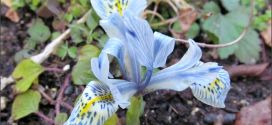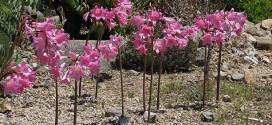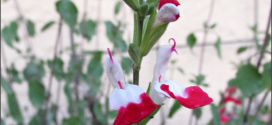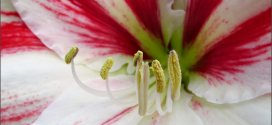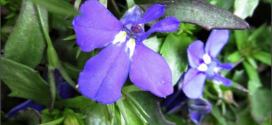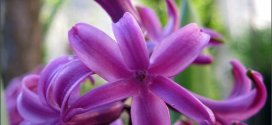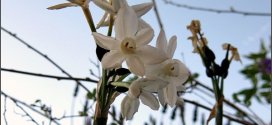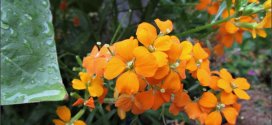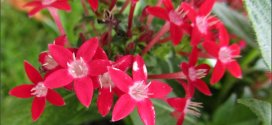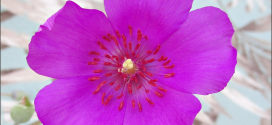Our native Pacific Coast irises include 11 species that produce flowers in shades of white, yellow, pink, lavender, even USC-worthy cardinal and gold. Most of the Pacific Coast irises, or Pacificas, sold in California are from a single species, Iris douglasiana. To learn about the foliage and flower distinctions behind each species classification, there is no better source than the …
Read More »Tag Archives: perennial
Amaryllis Belladonna – Pink Lady
Belladonna Lily, Pink Lady, Naked Lady, Amaryllis belladonna. In winter, the bulbs produce many leaves. The leaves die off by March. In the hot dry days of August, thick stocks shoot up from the bare ground (hence Naked Ladies).
Read More »Salvia – Hot Lips
Autumn Sage, Salvia x jamensis ‘Hot Lips’ Family: Lamiaceae (lay-mee-AY-see-ee) (Info) Genus: Salvia (SAL-vee-uh) (Info) Species: x jamensis Cultivar: Hot Lips Synonym:Salvia microphylla Category: Tropicals and Tender Perennials Height: 36-48 in. (90-120 cm) 4-6 ft. (1.2-1.8 m) Spacing: 18-24 in. (45-60 cm) Hardiness: USDA Zone 8a: to -12.2 °C (10 °F) USDA Zone 8b: …
Read More »Amaryllis – Christmas
Amaryllis, Christmas, Hippeastrum x ? Family: Amaryllidaceae (am-uh-ril-id-AY-see-ee) (Info) Genus: Hippeastrum (hip-ee-ASS-trum) (Info) Species: x ? Category: Bulbs Height: 18-24 in. (45-60 cm) Spacing: 6-9 in. (15-22 cm) Hardiness: USDA Zone 6a: to -23.3 °C (-10 °F) USDA Zone 6b: to -20.5 °C (-5 °F) USDA Zone 7a: to -17.7 °C (0 °F) USDA Zone …
Read More »Lobelia
Blue Lobelia, Lobelia siphilitica Family: Campanulaceae (kam-pan-yew-LAY-see-ee) (Info) Genus: Lobelia (low-BEE-lee-a) (Info) Species: siphilitica (sigh-fy-LY-tih-kuh) (Info) Category: Perennials Height: 24-36 in. (60-90 cm) Spacing: 18-24 in. (45-60 cm) Hardiness: USDA Zone 4a: to -34.4 °C (-30 °F) USDA Zone 4b: to -31.6 °C (-25 °F) USDA Zone 5a: to -28.8 °C (-20 °F) USDA …
Read More »Hyacinth
Dutch Hyacinth, Hyacinthus orientalis. Attractive to bees, butterflies and/or birds. Flowers are fragrant. This plant is suitable for growing indoors. Average Water Needs; Water regularly; do not overwater. Flowers are good for cutting Severe poisoning from hyacinth or tulip poisoning is often seen when dogs dig up freshly planted bulbs or having access to a large bag of them. When …
Read More »Narcissus – Paper White
Narcissus papyraceus (from papyrus and aceus; meaning paper-like), one of a few species known as “Paperwhite,” is a perennial bulbous plant native to the western Mediterranean region, from Greece to Portugal plus Morocco and Algeria. The species is considered naturalized in the Azores, Corsica, Texas, California and Louisiana. The white flowers are borne in bunches and are strongly fragrant. It …
Read More »Wallflower
From fast-growing clumps of strap-shaped foliage sprouted in early March, an abundance of bud clusters appear in April, which quickly pop open in an endless succession of very fragrant, absolutely neon-bright orange blooms well into mid-summer. Siberian Wallflower harmonizes beautifully with its fellow biennial Forget-Me-Not (Myosotis), the warm orange and cool sky blue. Despite the common name, Siberian Wallflower originated …
Read More »Pentas – Scarlet Red
Pentas are tropical blooming plants. When you know how to grow Pentas, you have a foolproof way of attracting hummingbirds and butterflies, too.
Read More »Calandrinia Spectabilis
Calandrinia is a plant genus that contains many species of purslane, including the redmaids. The genus was named for Jean Louis Calandrini, an 18th-century Swiss botanist. It includes around 150 species of annual herbs which bear colorful flowers in shades of red to purple and white. Plants of this genus are native to Australia, Chile, and western North America. This …
Read More »